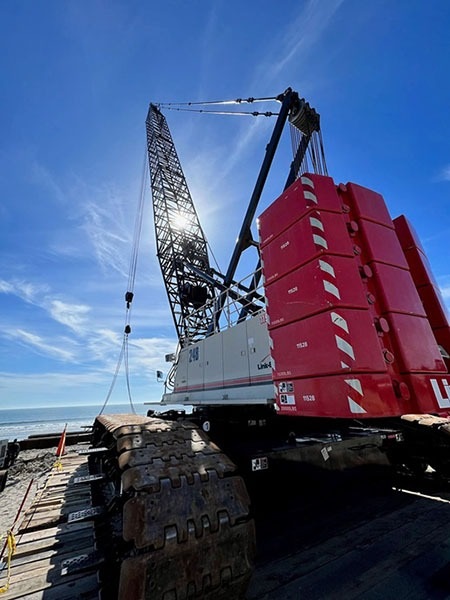
The situation: you need to get two cranes more than a quarter-mile into the ocean. What do you do?
You use those same two cranes to build the trestle that they’ll travel to reach their ultimate destination.
That’s the strategy for construction of the latest deepwater ocean outfall project in Myrtle Beach, South Carolina. Outfalls are pipelines that direct stormwaters into the ocean to reduce flooding, help prevent beach erosion, and lower the amount of bacteria in ocean water.
ALL Carolina Crane Rental of Wilmington, a member of the ALL Family of Companies, provided cranes for the state project to contractor Manson Construction. ALL specified two Link-Belt LS248HS lattice-boom crawler cranes, each with a 200-ton capacity and 155 feet of main boom.
The cranes will help lower 54-inch diameter CPVC pipe into the ocean, where underwater divers will make the necessary connections to construct the 1500-foot pipeline extending from the beach.
But before doing that, the cranes will help build the temporary trestle from which they will work once the project moves from land into deep water.
The cranes are fitted with vibratory pile driver attachments to drive sheet pile then use a diesel hammer to place round pilings to support the trestle. The next step is to set custom steel girders that will extend the length of the trestle into the ocean. Upon completion, crawler mats placed on top and anchored will allow the crawlers to walk out into the Atlantic and set the pipes.
“The farther out the pipe gets, the deeper it runs along the ocean floor,” said Bret Harvey, sales rep and project estimator for ALL Carolina Crane Rental. “Even though the pipes are relatively light, being made of CPVC, it’s important for our cranes to have a stable foundation from which to work.”
These same crawlers will also be used to move aggregate materials to cover the pipe after installation. Once the outfall pipeline is complete, the Link-Belt crawlers will help tear down the trestle as they walk toward land, leaving no evidence behind that the trestle was ever there.
Constructing two 200-capacity cranes near the beach in a resort community comes with its own set of challenges. For starters, crane sections had to be delivered one at a time to avoid overwhelming the narrow streets. “We had to build load by load, one section at a time,” said Harvey.
Assembly occurred in a parking lot near the beach that measured 40 feet by 180 feet, “That doesn’t leave a lot of room to build two cranes with 155-foot booms,” said Harvey. Especially when there’s much more than even the two cranes in the lot. Other equipment included bulldozers, a mechanic’s truck, and ALL’s assist crane to aid in assembly (first a 60-ton capacity Link-Belt 8660 truck crane then an 80-ton capacity Liebherr LTM 1070-4.2 all terrain crane).
Manson built a special temporary launch the finished crawlers could use to get from the parking lot, across the beach, to the tide line where trestle construction began.
“There’s not a lot of crane work that goes on here on the beach, other than building piers,” said Harvey. “This is a unique job and we’re glad to be a part of it.”

